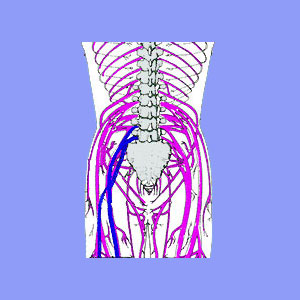
Sciatica diagnosis is the most problematic part of the entire treatment process. It is during this crucial time when the fate of the patient is truly decided. With one cast of the dice, a doctor can create the ideal circumstances for health or the descent into chronic pain, functional limitation, depression and even utter disability.
This resource section provides insight into the diagnostic process for sciatic nerve symptoms. We will explore a variety of diagnostic conclusions and provide patients with guidelines to help them succeed in treatment.
Sciatica Diagnosis Process
A patient develops a painful expression or neurological symptom and goes to the doctor for help. Maybe they had an obvious accident and suffered an injury, or maybe the pain just came out of nowhere. Regardless, the discomfort now exists.
The doctor will examine the patient and might even take some tests, such as x-rays or an MRI. The doctor will then weigh the evidence and come to a diagnostic conclusion.
In the vast majority of cases, some lumbar spinal abnormality will be discovered and blamed for the radiculopathy symptoms. It might be a herniated disc or what is often called degenerative disc disease.
Maybe the doctor does not like the look of some spinal osteoarthritis and speculates that there is a bone spur pressing on a nerve root, enacting foraminal stenosis. This condition is also sometimes diagnosed as a pinched nerve.
It is crucial that all patients understand the facts about theorized nerve root compression in order to prevent themselves from falling victim to misdiagnosis.
The discovery of spondylolisthesis or facet joint syndrome might be implicated as the suspected causation of pain.
Spinal stenosis is a common diagnosis in older patients and is often the source of many sciatica syndromes, even when it exists in the upper regions of the spinal anatomy.
If somehow there is no abnormal spinal condition found, the symptoms might be attributed to sacroiliac pain or even a piriformis pain syndrome. In some cases, the sciatic nerve is compressed by the piriformis muscle, causing a condition known as piriformis syndrome.
The least fortunate patients might be diagnosed with cauda equina syndrome, which can become an immediate medical emergency.
There is certainly no shortage of diagnosed conditions blamed for causing sciatic nerve pain. Trust me; this is just a very short list of some of the most common structural sources.
Read more about the diagnosis of sciatica neuropathy conditions.
Sciatica from lumbago is an antiquated diagnostic theory that is seldom correct.
Unexplained sciatica should be far more common, since statistics show little correlation between the typical structural diagnoses and the incidence of pain.
Are you suffering from myofascial pain or sciatica? Many doctors get it wrong!
In the most important dialog in this section, we will discuss why sciatica is not a diagnosis unto itself.
Diagnosis and Treatment of Sciatica
Ok, so now you know what is wrong with your spine. You are worried, but at least you understand what is causing your pain. The doctor comes up with a treatment plan and you are sure that you will be on your way to recovery in no time. Sound familiar? Yeah, to me too.
You do everything the doctor tells you, but you still have pain. You try some other recommendations from this doctor, but the pain remains and has actually gotten worse. Finally, you have endured enough and try a new doctor or maybe the doctor has had enough of you and refers you away to a colleague. Sound familiar? Yeah, to me, as well.
Well, after what has now become months, or even years, of trying everything to treat your sciatica pain, nothing has worked. What started as a moderate amount of pain has grown progressively worse and now you have extreme pain virtually every day.
Why has the pain gotten worse, especially after all these treatments?
What is going on here? Sound familiar? Yeah, to me too.
Sciatica Diagnosis Reality
The most common reason for a failure of any treatment to resolve any back pain condition is not due to any problem with the treatment itself. Instead, the problem lies way back in time with the original sciatica diagnosis. The vast majority of chronic sciatica patients have been misdiagnosed from day one and have been on a fool’s errand ever since. It is a sad fact, but completely true.
Misdiagnosed sciatica is virtually impossible to cure, since treatments are directed at a mistakenly identified source.
Speaking of misdiagnosis, read my article about a herniated disc pinching the sciatic nerve to clarify one of the most misunderstood diagnostic conclusions.
My Diagnosis
Diagnostic error was my reality, dating back to the tender age of 16. My first chiropractor blamed my pain on scoliosis and degenerative disc disease in my lumbar spine. Other doctors added to this diagnosis and eventually most were sure that the main concerns were my DDD and 2 herniated discs at L4/L5 and L5/S1.
My entire young adult life was spent in agony and torment, full of painful memories and unfulfilled dreams. I wasted tens of thousands of dollars trying to ease my recurrent acute and chronic back pain and found nothing but disappointment and financial hardship. However, just like you, I never once questioned my diagnosis. I became enraged that the treatments did not work, but never once thought maybe they were trying to treat the wrong source. The thought just never even occurred to me.
This was until I met Dr. John Sarno and took the time to speak to him regarding the common incidence of misdiagnosis in the dorsalgia sector of medicine. He explained that many of the typical structural diagnoses basically amount to nothing but smoke and mirrors. Sure, I had herniated discs, but so what? Lots of people do and they are not normally symptomatic. Ditto for my other conditions, especially the disc desiccation.
This led me to become ever more involved in my own care and to become a full time back pain scholar. I was amazed how much I was mislead over the years, once I took the time to read all the independent research which was available.
Sciatica Diagnosis and Misdiagnosis
I learned that in order to fully recover from some forms of back pain, you must be able to understand the facts about sciatica. You need to recognize the inconsistencies in the evaluation process and be able to refute the theory of a mistaken sciatica diagnosis. Once you can do this, you will be on the right path to becoming pain-free.
In summary, this page serves as a warning. If treatment fails, there is a good reason. When treatments fail over and over, the usual logical explanation is misdiagnosis. This is why we routinely advise patients to always seek a second opinion before beginning treatment.
There are many alternate reasons for sciatica to exist and these may not even be considered by specialists who have a tendency to over-focus on areas of the lumbar spinal anatomy and may not look at the big picture. It is a real world example of not seeing the forest for the trees.
We explain the entire sciatica diagnosis process, including many of the most common iatrogenic errors, in our extremely effective Cure Back Pain Forever Program, with particular emphasis placed on the subject in our Back Pain Misdiagnosis book.






